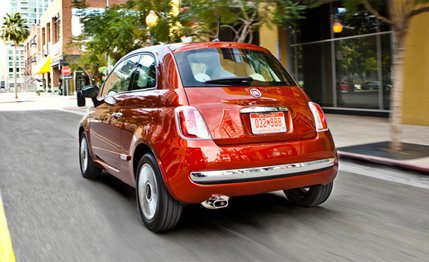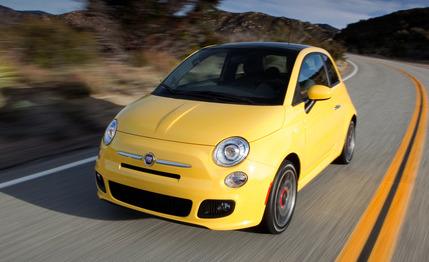 First Drive Review
First Drive Review
Fiat is reentering the U.S. market in a sector that is booming and the opposite of boring, and into which its infiltrator fits perfectly. Small-car segments are growing fast, and some of the most daring bodies in the business are among the smallest: the Nissan Juke and Cube, the Smart Fortwo, even stuff like the Ford Fiesta and upcoming Chevrolet Sonic and Spark ooze personality in a way few larger vehicles do. And, of course, the Fiat 500’s small, cute, and affordable approach is a close copy of the strategy that worked so well for Mini. If the 500 can match Mini’s average of about 40,000 U.S. sales a year, Fiat will be mighty pleased.
If you think you understand the Italians, consider the take of Roberto Giolito, the head of Fiat styling. He compares the original 500—or, in Italian, Cinquecento—to Bibendum, the Michelin spokesthing that, in his words, is “a fat man made from several tires.” He says this without a hint of irony and without the slightest consideration that a fat man made from tires might not be a good design goal for a car. It’s not just the original, either. He sees the same thing in the modern 500. We don’t quite see the same disarming heftiness, but have to admit that the car is cute.
More Colors than a Double Rainbow
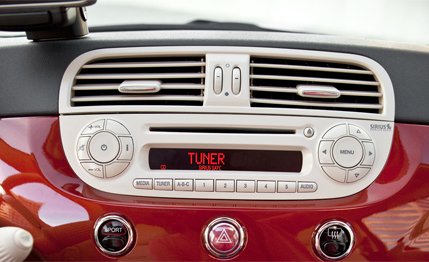
It’s retro-adorable inside, too, where an option swaps out the black surrounds for the HVAC and stereo controls for white Bakelite-look plastic. Checking this box also whitens the steering wheel and column—including the windshield-wiper and blinker stalks—as well as the trim around the gauge cluster. It’s actually not a cluster, really, but rather one enormous gauge comprised of concentric circles. In the middle is a digital display reporting engine temperature, fuel level, date, time, and exterior temperature. Wrapped around that is the tach, and around that the speedo. In reference to John Madden’s Thanksgiving feast—which consists of a chicken stuffed inside a duck stuffed inside a turkey and is referred to as a “turducken”—one C/D staffer called the monster gauge a “speedtachen.” If it sounds confusing, it isn’t. And no matter what info you want, you always know where to look. As a bonus, although the 500 might need a lot of time to reach top speed, at redline in every gear, the tach needle points to 120 mph on the speedo. So it’s got that going for it.
We love the optional white accents, but they do highlight the fact that the rest of what surrounds occupants is an interior befitting a $16,000 car. Hard, hollow black plastic makes up the top of the dash, the door panels, and the center console. And we noticed not all of the segments of the digital clock were uniformly illuminated. That and the fact that the HVAC controls felt as if they might fall off in our hands might sound nit-picky, but we haven’t had similar gripes about any other car in years.
The basic interior design is complemented by a page taken directly from the Mini playbook. (Actually, Fiat hasn’t just stolen a page; it has lifted the entire book. Where’s the FIA investigation?) In addition to the 14 available interior trim colors, some 50 accessories are available at launch, from interior lighting kits and roof racks to a variety of exterior graphics. Fourteen exterior colors are available for the 500, including two reds, yellow, orange, two different browns, and two greens.
High Standards
Fiat is hoping to distinguish the 500 further with its equipment. The base trim level, the Pop, includes power windows, locks, and mirrors; seven airbags; air conditioning; and cruise control. It’s not a ton of stuff, but neither is the $15,995 price. The company expects most of the sales volume to come from the middle trim level, the 500 Sport. For $17,995, the Sport adds 16-inch wheels (in place of the Pop’s 15s), unique fascias front and rear, a Bose sound system, and red brake calipers. At the top of the line sits the Lounge, at $19,995. It adds a six-speed automatic, a fixed glass roof, an alarm, satellite radio, and a leather-wrapped steering wheel. On Pop and Sport models, the automatic is a $1000 option. For reference, Honda Fit base prices range from $15,850 to $19,990, and the Nissan Cube’s, from $15,070 to $21,970.
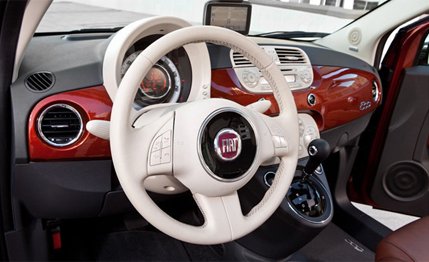
Unless you opt for the glass roof, the 500 is surprisingly spacious, thanks to the upright greenhouse. With the metal lid, even this six-foot-seven-inch writer was able to sit comfortably inside—as opposed to his experience in an original 500, which for him is best described as “partial outdoor seating.” But the glass roof knocks inches from the headroom and makes the car feel a bit more claustrophobic. The seats are comfortable, if a touch narrow. The latter also applies to the footwells, thanks to the intrusion of the wheel wells. Despite the lack of room in which to fidget, though, the 500 is very comfortable inside—not having anywhere to go might even teach antsy kids to sit still. But don’t think of the back seat as somewhere you’d ever store people; that space is strictly for grocery bags that need seatbelts.
Look at the Personality on That One
The new Cinquecento drives with as much personality as its shape boasts. The steering is quick and linear but a bit light. The Sport button on the dash (standard on all trim levels), should instead be labeled “Perfect,” as that’s what it makes the steering, dialing down the assist and opening up more feedback. It’s not Porsche perfect or Lotus perfect—customers drawn to the car’s styling would likely get talked right out of a purchase by that much communication through the wheel—but perfect in a relaxed, 101-hp-redux-of-a-car-featured-in-the-movie-Cars kind of way.
The whole car is 101-hp relaxed. The brakes are firm but not too much so. The clutch pedal feels as if it were attached to nothing at all, yet the takeup is so slow and progressive we had no trouble whatsoever launching the car smoothly and without overrevving the engine. And the shifter—topped by a knob the approximate size and finish of an eight ball—requires just the right amount of effort for a relaxing joy ride. The throws are a bit long, but tight throws demand concentration, which would be totally out of character.
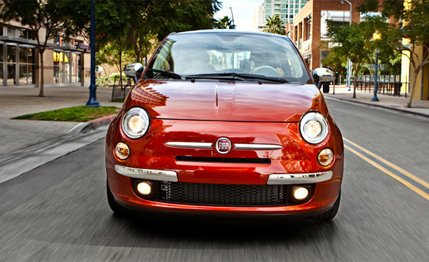
In a car so tall and narrow, a relaxed suspension might lead to toppling. But with such a short wheelbase, something too firm would result in a ride bordering on abusive. Fiat’s solution is a delightful balance, resulting in handling that is controlled and controllable without a harsh ride. Still, it might be a touch too aggressive for buyers who are looking for pink paint on the options list (don’t worry, they won’t find it). The short wheelbase means that finding lift-throttle oversteer is easy, but the car never feels as if it were going to snap scarily sideways. That’s good, because it’s highly unlikely you’ll be able to use more throttle to adjust your attitude at all.
The downside to this whole 101-hp relaxed business is that 101 is a small power number that results in some big numbers when it comes to acceleration times. Power-to-weight ratio is a faithful indicator of a car’s straight-line potential. The Corvette ZR1 carries 5.3 pounds per hp, the Bugatti Veyron 4.5. The Fiat 500? About 23.4. So, it’s no rocket. Such a small engine is going to get a good workout, and although the 1.4-liter four is not as eager to smack its redline as is a Honda motor, it never sounds pained. Still, on an incline moderate enough to be found in 40 of the contiguous United States—and most of the territories—we couldn’t maintain 65 mph in third gear. We doubt that buyers after cute are going to be comfortable downshifting to 5000 rpm. Those wanting more horsepower need only wait; the 500 Abarth will arrive in the U.S. in the first quarter of 2012.
For Our Shores Only
An automatic is available, of course. It’s an Aisin six-speed added to the lineup exclusively for the U.S. (In Europe, the only option other than the manual is a single-clutch automated manual that was promptly shot down by Fiat’s American ambassadors.) Fuel economy drops off dramatically with the automatic, to a Fiat-estimated 27 mpg city/34 highway from the stick’s 30/38. The automatic is smooth but not particularly sporty. It does have a manual shift gate, but it upshifts on its own at redline anyway and downshifts with no more enthusiasm than would a 1985 Ford Econoline, so there’s little other than a desire to delay upshifts and burn more gas to encourage drivers to shift for themselves. Still, Fiat expects 90 percent of customers to opt for the autobox—the car may be Italian, but those buyers will still be American.
The transmission is one of several substantial changes Fiat made to the 500 to bring it to the U.S. Our car has a redesigned rear suspension with more roll stiffness, as well as revised front-suspension geometry said to keep the car flatter. We get additional subframe bracing and revised shocks all around, and our car should be substantially quieter inside. Fiat has added sound-deadening material throughout the body, upgraded the door seals, and installed a better-insulated engine cover.
None of this much changes the car’s personality, and that’s what is likely going to draw most customers to the 500. Fiat is hoping to sell 50,000 a year in North America and is opening a string of 130 Fiat “studios” across the U.S. to support this volume. Some will be located in urban storefronts, but roughly one-third will be housed in former car dealerships from other brands, and ironically, Fiat tells us a number of those are former Hummer dealers. If ever there were an outsized success story, Hummer’s is it. We hope Fiat can avoid being the opposite end of that pendulum swing. The 500 is a good start.
